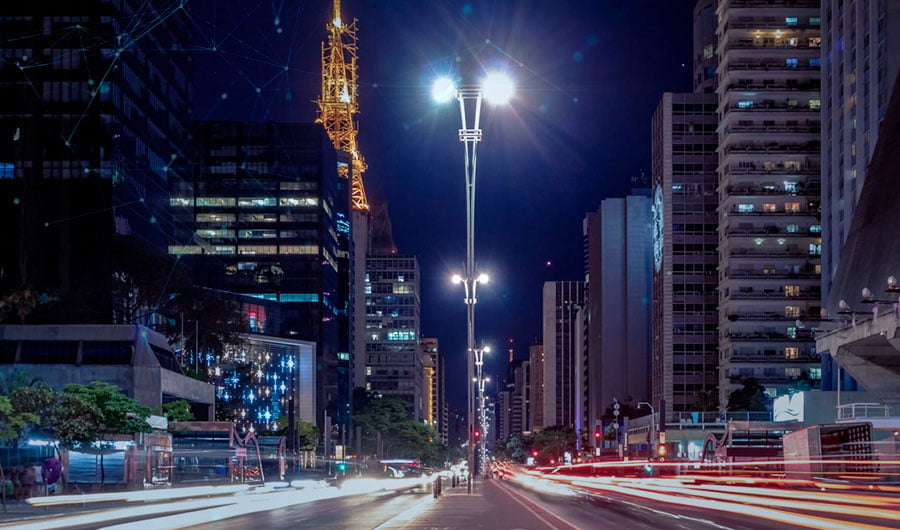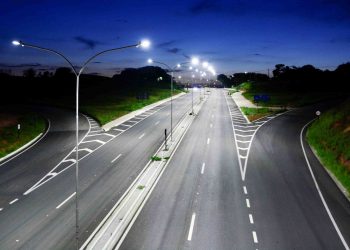
What is telegestion and what are its benefits?
Public lighting plays a vital role in our cities. Besides enabling movement and life during the night, it provides safety, guidance, and aesthetics. With the advancement of technology, telegestion systems for public lighting are increasingly gaining prominence as an innovative approach to improving energy efficiency, reducing operational costs, and promoting smarter management of urban infrastructures. In this article, we will explore the details of what these systems are and how they are revolutionizing the way we illuminate our streets and squares worldwide.
Understanding Telegestion
Telegestion is a system that remotely controls and manages public lighting networks. It combines the use of hardware and software to monitor lighting assets. The system is integrated into LED luminaires, which are widely used in the modernization of public lighting systems, such as SX Lighting luminaires, which are already prepared for automation.
Telegestion, in addition to receiving information from each lighting point, allows for precise measurements of voltage, current, power, and energy efficiency, providing valuable data for system maintenance. The operation of telegestion is based on a mesh network, where each public lighting point connects to other devices through wireless communication. This network allows for individual control of each luminaire, enabling adjustments in light intensity, fault detection, and scheduling of on/off times, for example.
Benefits of Telegestion Systems for Public Lighting
🔹Energy Efficiency: The ability to adjust lighting intensity based on environmental conditions, local light demand, and real-time needs results in significant energy savings;
🔹Cost Reduction: Quick fault detection allows for more efficient resource allocation and reduced operational costs, facilitating proactive maintenance and ensuring more efficient lighting.
🔹Sustainability: Reducing energy consumption in public lighting not only reduces expenses but also contributes to a lower carbon footprint, promoting more sustainable urban practices.
🔹Precise Control: Operators have precise control over lighting in different city areas and at different times, which can improve public safety and reduce energy wastage.
🔹Integration with other services for smart cities: Telegestion systems can be integrated with other smart city solutions, such as traffic monitoring, weather monitoring, flood alerts, air quality, and wireless internet routers, creating a more connected and efficient infrastructure, making life easier for citizens.
A Step towards the Evolution of Smart Cities
The implementation of LED lighting and telegestion is an important step in making cities smarter. This system is just one of many technologies that can be used in this process. Public lighting with LED technology for telegestion is a strategic starting point because it covers the entire city and allows for integration with other services and functionalities. Several cities around the world are already adopting telegestion as part of their modernization strategies.
For example, London is considered one of the leading smart cities globally and has been investing in the modernization of public lighting as part of this process. This trend is also present in Brazil, where several cities are implementing telegestion systems through public-private partnerships (PPPs).
What Telegestion Is and How It Works in Practice
Telegestion of public lighting involves the installation of control and monitoring devices in each luminaire. These devices are responsible for collecting and transmitting data to an operational control center, where they are interpreted and analyzed by management software. Based on this information, it is possible to identify faults, schedule maintenance, and adjust luminaire operation remotely. An important aspect of telegestion is the necessary infrastructure for monitoring.
The operational control center must have access to data centers, communication equipment, and screens for displaying lighting points. This infrastructure allows for real-time management, problem detection, and data collection for broader system analysis.
Essential Components in Telegestion Systems Include:
✔️ LED luminaires prepared for telegestion;
✔️ Wireless communication network technology;
✔️ Control center;
✔️ Management software;
The Potential of Telegestion for the Future of Cities
Telegestion of public lighting is just the preparation for the future, but a promising start to smart cities. With the evolution of technology, new possibilities will emerge, allowing for new service integrations and the creation of more interactive and efficient environments for city and population management; The connectivity provided by telegestion paves the way for the development of new applications and functionalities. For example, Bluetooth Low Energy (BLE) technology can be used to identify the presence of people, animals, and objects near luminaires.
This capability can be explored in areas such as public safety, traffic control, and real-time environmental monitoring. Telegestion of public lighting is a technology that is already revolutionizing smart cities. With remote and real-time control of LED luminaires, it is possible to achieve greater energy efficiency, cost reduction, and offer more integrated and interactive services to the population. The implementation of telegestion requires investment but brings significant benefits to municipalities, energy companies, and, most importantly, citizens. It is a step towards an increasingly technological and promising future. It is exciting to see how public lighting is becoming more than just light but an essential part of connected, sustainable, and smart cities.
Share






